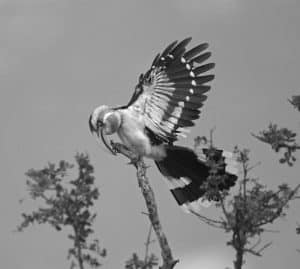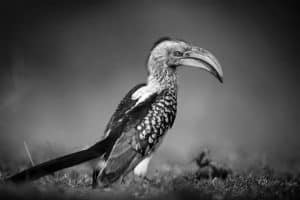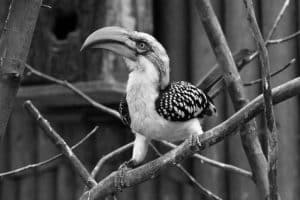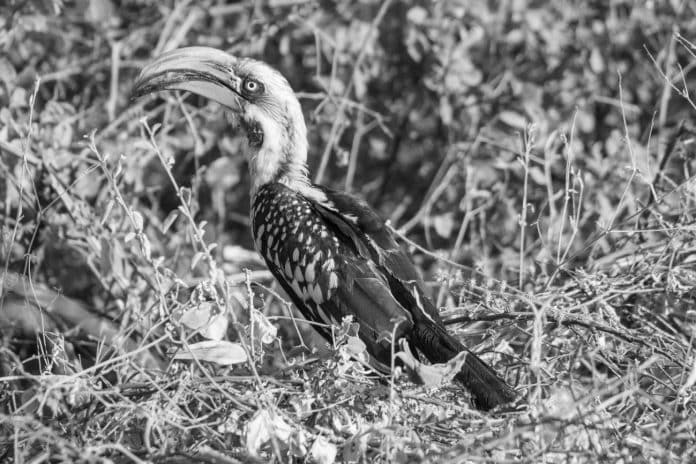Introduction to the Eastern Yellow-Billed Hornbill
The Eastern Yellow-Billed Hornbill, scientifically known as Tockus flavirostris, is a captivating bird species found in the woodlands and savannas of eastern Africa, particularly in Tanzania. This stunning avian creature belongs to the hornbill family, known for its striking appearance and unique characteristics. The Eastern Yellow-Billed Hornbill in Tanzania is a symbol of the vibrant biodiversity that graces the Tanzanian landscape, captivating bird enthusiasts, wildlife photographers, and nature lovers alike.

Originating from the Bucerotidae family, the Eastern Yellow-Billed Hornbill exhibits distinctive features that set it apart from other bird species. Its defining traits include a striking yellow beak with a pronounced casque, a black and white plumage, and a long tail. These attributes contribute to the bird’s unmistakable silhouette as it soars through the Tanzanian woodlands. The hornbill’s mesmerizing physical attributes are complemented by its fascinating behavioral patterns, making it a subject of intrigue and admiration for researchers and wildlife enthusiasts.
The Eastern Yellow-Billed Hornbill is renowned for its enchanting presence in the woodlands of Tanzania, where it plays a vital role in the ecosystem’s balance. From its foraging habits to its nesting behavior, the hornbill’s interactions with its environment demonstrate the intricate web of life within the Tanzanian woodlands. By delving into the habitat and distribution of the Eastern Yellow-Billed Hornbill, one can gain a deeper appreciation for the significance of this avian marvel in the region’s natural tapestry.
Habitat and Distribution of the Eastern Yellow-Billed Hornbill in Tanzania
The Eastern Yellow-Billed Hornbill’s habitat encompasses the diverse landscapes of Tanzania, including woodlands, savannas, and open country with scattered trees. This adaptable bird species thrives in semi-arid and arid regions, utilizing its keen foraging skills to locate food sources within its preferred habitats. The hornbill’s distribution spans across various regions of Tanzania, with a notable presence in national parks, game reserves, and protected areas that showcase the country’s rich biodiversity.
In the woodlands of Tanzania, the Eastern Yellow-Billed Hornbill finds refuge amidst the towering trees and shrubbery, where it can forage for insects, small reptiles, and fruits. These woodlands provide an ideal setting for the hornbill to display its aerial prowess, as it navigates through the canopy in search of sustenance. The bird’s territorial nature and nesting preferences further influence its choice of habitat, shaping its distribution patterns within the Tanzanian landscape.
The Eastern Yellow-Billed Hornbill’s presence in Tanzania’s woodlands is a testament to its resilience in adapting to diverse environmental conditions. Its ability to thrive in the region’s varying habitats underscores the importance of preserving these ecosystems for the long-term survival of this mesmerizing bird species. By understanding the intricacies of the hornbill’s habitat and distribution, conservation efforts can be tailored to safeguard its presence in the Tanzanian woodlands.
Physical Characteristics and Behavior of the Eastern Yellow-Billed Hornbill
The Eastern Yellow-Billed Hornbill’s physical characteristics are a sight to behold, captivating observers with its distinctive appearance and graceful movements. Its most prominent feature is the striking yellow beak that contrasts with its black and white plumage, creating a visually stunning spectacle amidst the verdant backdrop of the Tanzanian woodlands. The hornbill’s elongated tail and robust build further contribute to its commanding presence, making it an iconic symbol of avian splendor in the region.
In addition to its captivating appearance, the Eastern Yellow-Billed Hornbill exhibits fascinating behaviors that reflect its adaptation to the Tanzanian woodlands. One of its notable traits is its foraging technique, which involves probing and pecking at the bark of trees to unearth insects and small prey. This distinctive feeding behavior showcases the hornbill’s resourcefulness in sourcing nourishment from its woodland habitat, highlighting its role in regulating insect populations and contributing to the ecosystem’s balance.
Beyond its foraging habits, the Eastern Yellow-Billed Hornbill’s nesting behavior is a testament to its commitment to perpetuating its species. The female hornbill selects a suitable tree cavity for nesting, where she seals herself inside using a combination of mud and feces, leaving only a narrow slit for receiving food from the male. This unique nesting strategy offers protection from potential predators and underscores the hornbill’s dedication to ensuring the survival of its offspring in the dynamic woodlands of Tanzania.
Importance of the Eastern Yellow-Billed Hornbill in Tanzanian Woodlands

The Eastern Yellow-Billed Hornbill occupies a pivotal role in the intricate tapestry of life within the Tanzanian woodlands, contributing to the ecosystem’s balance and functioning. As a key predator of insects and small reptiles, the hornbill helps regulate populations of these organisms, preventing unchecked population growth that could disrupt the delicate ecological equilibrium. By controlling the abundance of these prey species, the hornbill indirectly influences the dynamics of the woodland food web, showcasing its significance in maintaining biodiversity.
Furthermore, the Eastern Yellow-Billed Hornbill serves as a vital seed disperser, consuming fruits and later regurgitating the seeds in different locations as it moves through the woodlands. This process of seed dispersal plays a crucial role in the regeneration of plant species, contributing to the perpetuation of the woodland flora and the preservation of diverse habitats. The hornbill’s foraging activities thus extend beyond mere sustenance, encompassing an essential ecological function that supports the resilience and diversity of Tanzania’s woodlands.
In addition to its ecological importance, the Eastern Yellow-Billed Hornbill holds cultural significance for local communities, featuring prominently in Tanzanian folklore and traditional beliefs. Its presence in indigenous narratives reflects the deep-rooted connection between the hornbill and the cultural heritage of the region, underscoring its symbolic value as a revered figure in the collective consciousness of Tanzanian society. This blend of ecological and cultural significance highlights the multifaceted role of the Eastern Yellow-Billed Hornbill in shaping the identity of the Tanzanian woodlands.
Conservation Efforts for the Eastern Yellow-Billed Hornbill
Preserving the radiance of the Eastern Yellow-Billed Hornbill requires concerted conservation efforts aimed at safeguarding its natural habitats and addressing potential threats to its survival. In Tanzania, initiatives focused on habitat protection and restoration play a pivotal role in ensuring the long-term viability of the hornbill’s woodlands. By designating and managing protected areas that encompass the bird’s key habitats, conservation organizations and government agencies strive to create sanctuaries where the hornbill can thrive without the pressures of habitat degradation and encroachment.
Furthermore, community-based conservation programs engage local residents in efforts to conserve the Eastern Yellow-Billed Hornbill and its woodland habitats. By fostering partnerships with indigenous communities, conservationists aim to promote sustainable resource management practices that harmonize with the hornbill’s ecological needs. These collaborative endeavors empower local stakeholders to become stewards of the woodlands, nurturing a sense of shared responsibility for preserving the natural heritage that encompasses the Eastern Yellow-Billed Hornbill and its diverse ecosystem.
In addition to habitat-focused initiatives, education and awareness campaigns play a crucial role in advocating for the protection of the Eastern Yellow-Billed Hornbill. By informing the public about the bird’s ecological importance, cultural significance, and the challenges it faces, conservation organizations seek to inspire collective action in support of the hornbill’s conservation. Through outreach activities, workshops, and educational materials, these efforts aim to foster a deeper appreciation for the hornbill and galvanize support for its preservation among diverse audiences.
Best Places for Bird Watching and Spotting the Eastern Yellow-Billed Hornbill in Tanzania
Tanzania’s expansive and diverse landscapes offer a multitude of opportunities for bird enthusiasts and wildlife aficionados to witness the resplendent beauty of the Eastern Yellow-Billed Hornbill in its natural environment. From the iconic savannas of the Serengeti to the lush woodlands of the Manyara region, the country abounds with prime locations for bird watching and spotting the hornbill’s radiant presence. Each of these destinations provides a unique setting for observing the hornbill’s behaviors and interactions, creating unforgettable experiences for visitors seeking to connect with Tanzania’s avian treasures.
The Tarangire National Park stands out as a premier site for encountering the Eastern Yellow-Billed Hornbill, offering expansive woodlands and riverine habitats that are favored by the bird. As visitors explore the park’s diverse terrain, they may witness the hornbill’s aerial displays, foraging activities, and nesting behaviors, providing a comprehensive glimpse into its captivating lifestyle. The park’s rich birdlife, coupled with the presence of the hornbill, makes it a must-visit destination for bird watching enthusiasts eager to immerse themselves in Tanzania’s natural splendor.
In addition to the Tarangire National Park, the Lake Manyara National Park presents an enchanting setting for observing the Eastern Yellow-Billed Hornbill amidst verdant forests and acacia woodlands. The park’s diverse ecosystems offer a mosaic of habitats where the hornbill thrives, allowing visitors to witness its interactions with other bird species and the surrounding environment. From the canopy to the forest floor, the hornbill’s presence in Lake Manyara National Park offers a captivating spectacle that embodies the allure of Tanzania’s woodlands and their avian inhabitants.
Unique Behaviors and Interactions of the Eastern Yellow-Billed Hornbill
The Eastern Yellow-Billed Hornbill’s repertoire of behaviors and interactions within the Tanzanian woodlands reflects the intricate dynamics of its ecological niche and social relationships. One of the hornbill’s unique behaviors is its cooperative breeding strategy, characterized by the collective efforts of a breeding pair and additional helpers in raising offspring. This cooperative breeding system involves cooperative nest building, incubation, and feeding, showcasing the hornbill’s social complexities and the cooperative nature of its familial bonds.
Furthermore, the Eastern Yellow-Billed Hornbill displays intriguing interactions with other bird species and wildlife within its woodland habitat. Its aerial displays and vocalizations serve as communication tools that convey territorial boundaries, mating signals, and social cues to conspecifics and neighboring organisms. These interactions contribute to the broader ecological fabric of the woodlands, shaping the dynamics of species coexistence and resource utilization within the hornbill’s intricate web of relationships.
The hornbill’s interactions with its environment extend beyond its immediate social circle, encompassing its role as a seed disperser and insect predator. Through its foraging activities and movements across the woodlands, the hornbill influences the distribution of plant species and the abundance of insect populations, exerting a subtle yet significant impact on the ecological processes that shape the Tanzanian woodlands. By unraveling the intricacies of the hornbill’s behaviors and interactions, researchers and enthusiasts gain a deeper understanding of its role in the complex tapestry of woodland life.
Cultural Significance of the Eastern Yellow-Billed Hornbill in Tanzanian Folklore

In Tanzanian folklore and traditional beliefs, the Eastern Yellow-Billed Hornbill occupies a revered position as a symbol of wisdom, strength, and spiritual significance. The hornbill’s striking appearance and distinctive behaviors have inspired narratives and allegories that celebrate its role as a revered figure in indigenous cultures. Across different ethnic groups and communities, the hornbill is often depicted as a messenger of the spirit world, a guardian of sacred knowledge, and a symbol of resilience in the face of adversity.
The hornbill’s presence in local folklore is intertwined with stories of creation, ancestral spirits, and the interconnectedness of human and natural realms. Its iconic silhouette and evocative calls have become emblematic of enduring traditions and the enduring legacy of the Tanzanian woodlands. As a cultural icon, the Eastern Yellow-Billed Hornbill transcends its ecological significance, embodying the richness of Tanzanian heritage and the timeless wisdom embedded within the tapestry of folklore and oral traditions.
Moreover, the hornbill’s cultural significance extends to artistic expressions, rituals, and ceremonial practices within Tanzanian communities. From intricate carvings and adornments to ceremonial dances and symbolic representations, the hornbill’s imagery permeates various aspects of cultural expression, reflecting its enduring influence on the artistic and spiritual dimensions of Tanzanian society. This fusion of cultural significance and ecological prominence underscores the profound impact of the Eastern Yellow-Billed Hornbill on the collective consciousness of Tanzanian communities.
Challenges and Threats Facing the Eastern Yellow-Billed Hornbill
Despite its symbolic significance and ecological importance, the Eastern Yellow-Billed Hornbill faces a myriad of challenges and threats to its continued existence in the Tanzanian woodlands. Habitat loss and fragmentation due to human activities, including agriculture, logging, and infrastructure development, pose significant threats to the hornbill’s natural habitats, leading to the degradation and isolation of its woodland refuges. These habitat alterations disrupt the hornbill’s foraging opportunities, nesting sites, and territorial integrity, compromising its ability to sustain viable populations.
Furthermore, the illegal wildlife trade and poaching activities present a direct threat to the Eastern Yellow-Billed Hornbill, as the bird’s striking appearance and cultural significance make it a target for illicit exploitation. The demand for hornbill casques, feathers, and other body parts in traditional medicine, ornamental trade, and ritual practices perpetuates the illegal harvesting of hornbills, contributing to population declines and conservation challenges. These detrimental practices undermine efforts to protect the hornbill and undermine its conservation status in the Tanzanian woodlands.
Climate change and its associated impacts, such as altered precipitation patterns and increased frequency of extreme weather events, pose additional challenges for the Eastern Yellow-Billed Hornbill and its woodland habitats. These environmental changes can disrupt the availability of food resources, affect breeding success, and alter the dynamics of species interactions within the hornbill’s ecological niche. As the Tanzanian woodlands grapple with the repercussions of a changing climate, the hornbill confronts new uncertainties that necessitate adaptive conservation strategies to mitigate potential threats.
Conclusion: Preserving the Radiance of the Eastern Yellow-Billed Hornbill
The Eastern Yellow-Billed Hornbill stands as a radiant emblem of the Tanzanian woodlands, captivating all who behold its resplendent presence amidst the verdant tapestry of the region. As a species of ecological importance and cultural significance, the hornbill embodies the interconnectedness of biodiversity, heritage, and the enduring allure of Tanzania’s natural heritage. To ensure the continued radiance of the Eastern Yellow-Billed Hornbill in the woodlands of Tanzania, concerted efforts are imperative to address the challenges it faces and safeguard its place in the country’s ecological and cultural legacy.

































